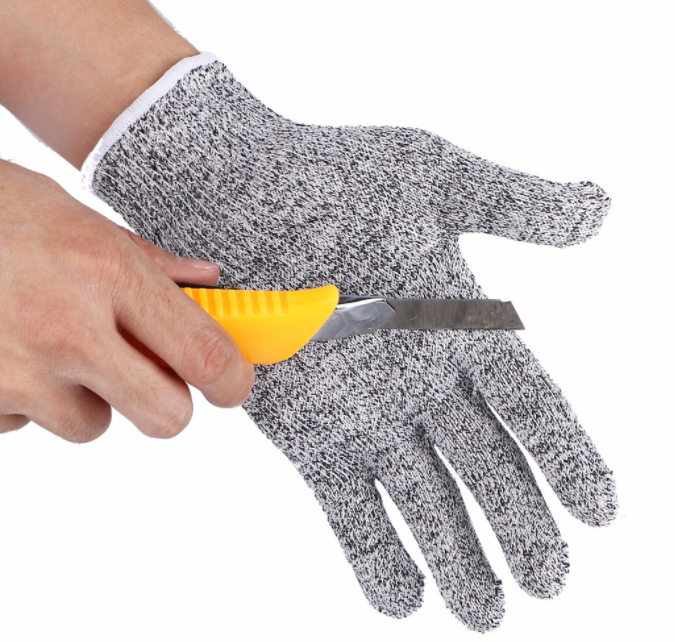In personal protective equipment (PPE), cut-resistant gloves can protect the wearer's hands from cuts while working with sharp tools. Cut-proof gloves divided into metal mesh gloves, cut-and-sewn, and seamless knitted gloves.
Metal mesh gloves are a form of stainless steel. They are typically used in food applications.
Cut-and-sewn gloves are using a cut-resistant material or by using conventional materials with full or palm lining of cut-resistant materials.
Seamless knitted gloves are knitted in one piece by a flat knitting machine. The cut protection is provided by high-performance materials such as para-aramid (Twaron, Kevlar), high-performance polyethylene (HPPE), special polyvinyl acetate (PVA) yarns (SupraBlock), or steel wire and fiberglass yarns. Knitting machines are commonly classified using gauge and can range from 7 meters through 18 and 21 gauge. The gloves are coated with solid or foamed latex, nitrile, or polyurethane.

In cut-proof fibers, there is “rolling action,” which means that the filament fibers can move loosely, and the motion absorbs some of the impacts from the blade. A rope-tied taut between two points and trying to cut through it with an ax – cuts pretty quickly, but,that same rope tied to the same two points but instead of being taught, it’s hanging loosely. Can the ax still cut through quickly? Probably not – that is why anti-slash gloves can protect you.
Some yarns inherently contribute more than others to the rolling action, or “slipperiness,” of the fiber. For instance, there is much debate over which is more robust, Kevlar or Dyneema, but there is no question that Dyneema (or HPPE) is more slippery than Kevlar. This inherent slipperiness helps blades glide over the fiber rather than cutting through it. HPPE is so tricky that when it’s extruded as a sheet, it can be used as an artificial skating rink, allowing the skate blades to glide along without cutting through.
The type of cut-resistant glove material used in the manufacturing process mainly depends on their intended application. Required specifications for one industry may vary significantly from what you would choose for another.
Workplace Safety with Cut Resistant Gloves
T-safety leads the industry in high-quality cut-resistant work gloves. Cut-resistant glove performance tests indicate that metal mesh offers the highest cut resistance level, followed by composite yarns and high strength fibers. Our hardworking customers expect protection in their cut-resistant gloves. Our gloves have proven their value in the automotive, construction, food processing, pulp and paper, metalworking and oil and gas industries. Use our glove search refinement tool to find the level of cut resistance, abrasion resistance, color, cuff and palm coating options to ensure you are using the right anti-cut work glove for your hand protection and safety needs.
These are some typical applications where you would use cut-resistant gloves:
Aeronautics and Aerospace
Agriculture
Assembly
Automotive
Construction
Electronics
Fabrication
Forestry and Lumber Mills
Glass Products
Mining
Paper Industry
Plastics and Rubber
Steel Foundries
The significant injuries you will prevent or minimize with cut-resistant gloves are abrasions, lacerations, and punctures. The primary injury locations are your fingers, thumbs, backs, and palms of your hands. Manufacturers design each cut-resistant glove to give priority to different regions. Your job is to determine your highest risk area and choose gloves built to protect these vulnerable parts.
| EN 388 Mechanical Ratings: | |||||||
| Number | Rating | Level 0 | Level 1 | Level 2 | Level 3 | Level 4 | Level 5 |
| 1 | Abrasion Resistance (Cycles) | < 100 | ≥ 100 | ≥ 500 | ≥ 2000 | ≥ 8000 | - |
| 2 | Cut Resistance (Cycles) | < 1.2 | ≥ 1.2 | ≥ 2.5 | ≥ 5.0 | ≥ 10.0 | ≥ 20.0 |
| 3 | Tear Resistance (Newtons) | < 10 | ≥ 10 | ≥ 25 | ≥ 50 | ≥ 75 | - |
| 4 | Puncture Resistance | < 20 | ≥ 20 | ≥ 60 | ≥ 100 | ≥ 150 | - |
Machine-Washing Your Gloves
Check the tag to see if you can machine-wash the gloves. Many cut-resistant gloves can wash with the machine, but some gloves may be destroyed in the washer. Look at the inside lining of the glove near the wrist and read the tag to see if the gloves can be machine-washed. You can typically wash the cutting gloves made out of fabric, but the mesh gloves made out of metal are not machine washable.
Hand-Washing the Gloves
If you use the gloves to cut food, wash the gloves by hand after every use. This will keep bacteria and residue from transferring from the gloves to your food. For other services, hand-wash the gloves whenever they become visibly dirty.
Wring your hands together like you're washing your hands for 1-2 minutes. Rub your palms together to spread the soap out in your hands. Interlock your fingers and move them back and forth to lift dirt out from between the fingers.
Copyright © Hebei Sinotools Industrial Co.,Ltd. All Rights Reserved | Powered by  Sitemap
Sitemap